In a mountainous area of Wenzhou City in Zhejiang Province, China, people still make paper in a traditional way. The paper is made from bamboo, which is cut from the mountains and fields and then passes through a complicated process of several stages taking over half a year. This would make it the most sumptuous paper in the world. This paper is used for ...
When I was tidying up my study in a university building at the end of last year, a piece of paper fell from an old notebook. The notebook was a field notebook that I had used when I surveyed a mountain village in China more than a decade ago. The paper was yellow green in color, handmade and had the same texture as Japanese paper (washi). It was rectangular in shape and approximately A5-size. and in very good condition despite having been left lying around for more than ten years.
Paper made in ancient China and imported to Japan is called "China paper" (to-shi). Most China paper, which was introduced from the Eurasian continent, was flimsy, low-quality paper, made mainly from hemp rags. Although my olive drab piece of paper is not of prominently high-quality, I somewhat hesitate to call it "China paper" since it is not made from rags. Also, though the texture is very similar to that of Japanese paper, it can not be called "washi" either, because the term washi means, of course, paper made by processes peculiar to Japan. My paper is genuinely Chinese-made, so the term washi is not appropriate. In fact, the material of my hand-made paper is quite different from those used for washi. My paper is made from bamboo, which gives it the above-mentioned olive drab color. These days, some kinds of washi are also made from bamboo, but these seem to have a very short history compared to Chinese bamboo paper. In China, people have used bamboo to make paper since very early times. Further, among the many kinds of bamboo paper, the one which I have a piece of seems to be the most sumptuous paper in the world.
Chinese Paper
As is widely known, present-day paper, which is made from plant fibers, is considered to have had its origin in China. Of course, since paper such as parchment, which is made from the skins of animals like sheep and so on, and papyrus, which is considered to be the origin of English word "paper," preceded Chinese paper as an underlying medium simply for writing characters on, and thus paper as a recording medium may have its roots elsewhere. The manufacturing processes of these kinds of paper were also entirely different from that of present-day paper, made by pulping source plants into plant fibers by pounding and then scooping and spreading the fibers evenly onto a screening tray in water, followed by drying.
A Chinese eunuch, Cai Lun, is conventionally regarded as being the inventor of paper. When he was the chief of the Shang-fang ling (ฎ๛฿), an office for manufacturing instruments used at the court, in the middle period of The Later Han Dynasty, he presented to the then Emperor He several kinds of paper made from materials such as tree bark, hemp cloth and fish net, which were later called "Marquis Cai's paper." That was about 1900 years ago, in 105 A.D. In reality, his achievements and his position as the inventor of paper are now questioned because of archaeological discoveries since the beginning of 20th century that have revealed that paper-like material was already used before Cai Lun's invention. However, his contribution to the systematization and prevalence of the paper manufacturing process is unfading. Thanks to his great achievements, the amount, reliability, and durability of information communicated between people drastically increased. It is no exaggeration to say that his achievement is one of the great inventions that transformed the world. Since then, paper has supported the Chinese culture of letters as the "underlying layer."
The process spread throughout the world, and was of course introduced to Japan to bring about washi, while people in China, the home of paper, started to make paper using different materials from those used in Japanese paper making. In fact, they started to use bamboo.
Pan Jixing, who is the most famous researcher of the history of Chinese paper-making techniques, argues that the first article on bamboo paper appears in the "Tang guo shi bu" (Additional History of Tang) written by Li Zhao in the 9th century, which says that bamboo paper was manufactured around the area of the present-day Shaoguan City in Guangdong Province (Pan 1980j. According to this contention, bamboo paper and its manufacturing techniques were developed after the establishment of the Tang Dynasty. Bamboo paper is reported to have been further improved in the Song Dynasty.
Paper manufacturing that use bamboo as material developed in Jiangnan, as described in Zhipu in the Wenfang Sipu, written during the Northern Song in the late 10th century, "In Jiangnan, the area around the lower reaches of the Yangtze River, there are some places where people make paper from young bamboo." Using Pan's phrase mentioned above, "Bamboo paper produced around Jiangnan in the Song Dynasty had a reputation second to none." iPan 1980F162j Many writers and artists appreciated the quality of bamboo paper, which had a smooth surface, showing good color when used with Chinese ink, and was gentle to the tip of a brush. Su Shi (Su Dongpo), one of the most famous writers of the North Song, favored bamboo paper, which indicates the popularity of bamboo paper at that time. In the Tang and Song periods, when the demand for paper increased in China and people started to have difficulty in obtaining enough source material, bamboo caught people's attention as it grew in abundance all around them. Since bamboo was probably the one of the most common plants, particularly in the southern part of China such as Jiangnan, utilization of the plant as a resource was an epoch-making event. Detailed descriptions of bamboo paper-making techniques can be found with illustrations in the Tiangong Kaiwu , a book on technology written at the end of the Ming Dynasty (the beginning of the 17th century).
The Technology of Making Bamboo Paper as seen in the Tiangong Kaiwu
Song Yingxing, the author of Tiangong Kaiwu, distinguishes between the two kinds of paper of the time by their raw materials: bark paper, which is made from tree bark, and bamboo paper. There seems to be no significant difference between their manufacturing processes. At any rate, the main production area of bamboo paper being the southern part of China. The book states that, "Production of bamboo paper began in the south, and is particularly flourishing in Min (which is now Fujian Province)," claiming that Fujian, located in southern China, is rich in bamboo resources, and is the main bamboo paper producer. In contrast to the north, where there was not enough bamboo, forcing people to recycle sheets of waste paper and scraps of paper picked up on the roadside, people in southern China were provided with abundant bamboo, which was available at low price and thus there was no need to worry about short supply.
Young bamboo that is just about to foliate and shoot out branches is a good raw material for making bamboo paper. After Mangzhong (around June 6th of the solar calendar), people cut bamboo from the mountains, and soaked it in a pond for more than 100 days. After that, it was lifted out of the pond, hammered, and then the shell and green skin were washed away. Lime water was then applied to the resulting material, and the mixture was boiled in a pot for eight days and nights, following which it was left for a day after extinguishing the fire. The zhuma (bamboo fiber) was then taken out of the pot and washed in a pond filled with clean water. It was then washed with a solution of firewood ash, placed in a pot and boiled again after adding rice straw ash to the pot. After approximately 10 days of repeated cooling, adding of ash water and boiling, the fiber begins to decay. It is then pounded to pulp with a shuidui (water-powered pounding mill), poured into a cao (straining tray), and strained. Strained layers of paper are built up in this way, and after reaching a certain height, a board is placed on top of the layers, and pressed down with stick, rather like in Japanese sake production, to squeeze out water. When the moisture has been fully squeezed out, the paper is stripped off sheet by sheet, and dried using a brick oven. As can be seen from the above long list of procedures, the bamboo paper-making process is extremely complicated and time-consuming.
It was not only for writing and painting that people used paper at that time. It was also closely related to the religious beliefs of the people. According to the Tiangong Kaiwu, people burned paper money (zhiqian) instead of silk cloth (as an offering) to worship guishen, a demon-like deity, during the peak period of the Tang Dynasty. Paper money was in the form of pieces of paper intended to be used as money in the afterlife, a kind of offering. It is still used today when performing the memorial rite for a deceased person and in other ritual offerings to the Netherworld and Heaven.
A Paper Making Village
Now, concerning the piece of paper I mentioned at the outset, it closely
resembles the bamboo paper illustrated in the Tiangong Kaiwu. I first
discovered this olive drab paper in 1992, deep in the mountains of
Wenzhou City, Zhejiang Province. Wenzhou City is the cultural and economical
center of the southern coastal area of Zhejiang Province, and has developed
rapidly as an economic development zone over the last ten or so years.
In particular, individually-owned commercial and industrial enterprises
have developed and the people's living standard is rapidly improving.
This success is attracting attention as the "Wenzhou model." However,
Wukeng Village in Zeyazhen (Zeya Town), turned out to be a remote farming
village, reached only after a 90-minute road journey into the mountains
from the central part of Wenzhou City, and then a one-hour climb up
a narrow stairway along the side of a steep canyon.
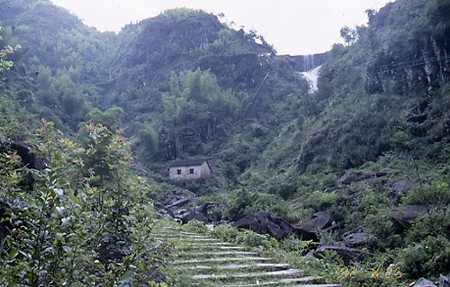 |
Wukeng Village, a paper-making village, is located beyond the mountain in this picture. |
The village had about 120 houses, and a population of about 700. Most of the inhabitants bore the family name Wu or Lin and were engaged in traditional paper manufacturing as a secondary job besides farming, which was their main means of livelihood. The region around this mountain area is one of the major production areas of the bamboo paper, Nanping paper. Nanping is said to be the name of a place in Fujian Province, from where, according to legend, the ancestors of the people in this region emigrated, bringing with them the paper-manufacturing techniques. The Tiangong Kaiwu, mentioned above, says that bamboo paper production flourished in Fujian Province, and thus the paper making in Wukeng Village is the very descendant that has inherited the tradition of bamboo paper making from Fujian. The manufacturing process of bamboo paper in Wukeng Village is very similar to that appearing in the Tiangong Kaiwu.
The bamboo paper manufactured in Wukeng Village uses mainly water bamboo (shuizhu)iPhyllostachys heteroclada Oliv.jas material. Moso bamboo (maozhu) is also used, but in small amounts. The villagers use young, one- or two-year-old, water bamboo stems of about five cm in diameter. This bamboo is considered to have been brought in when the people emigrated from Fujian Province. Though each of the villagers grows bamboo in the mountains, the amount of bamboo produced in the village was not sufficient to fill demand, so it was necessary to import some bamboo from nearby districts (xian) and from Fujian Province.
The bamboo is cut and disbranched with a dadao, which is a specially
made chopper with a hooked tip. It also closely resembles the cutting
tool recorded in the Tiangong Kaiwu. After cutting the bamboo from
the mountain, each bamboo stem is cut into lengths of around 80 cm
in length, and then hammered. After that, the stems are dried in the
sun for one to two months. The villagers then used to boil the stems
in a pot, following the same procedure as described in the Tiangong
Kaiwu, but the boiling process is skipped in the present day. After
a long period of drying, the stems are tied in bundles of six kg each,
and then soaked in a pond called a yantang. Putting lime into the water
so that the weight ratio of bamboo to lime is 4 to 1, and soaking in
this limewater for two to three months causes the bamboo to become
much softer. In ancient times, people apparently used the ashes of
burned oyster shells or burned plants, but lime is said to be more
effective. Because of that, people started to use lime and skip the
process of boiling in a pot.
 |
Water bamboo |
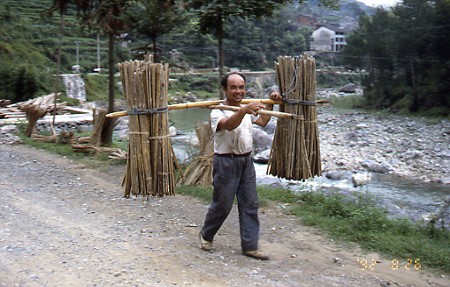 |
Carrying cleaved bamboo |
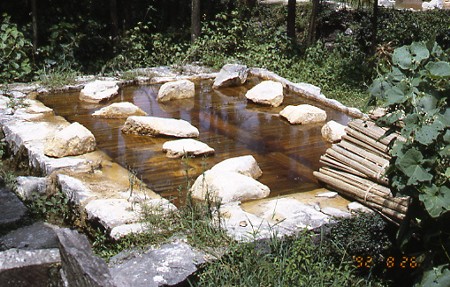 |
The bamboo is softened by soaking in a pond of limewater for
two to three months. |
Bamboo lifted out of the pond after two to three months is called shua. This is washed in the river before going on to next procedure. It is then pounded with a water-powered pounding mill called a shuidui, and the resultant fine fibers, called xishua, will be used as the raw pulp material for paper making. As mentioned above, the way to Wukeng Village is closely hemmed in by a steep canyon. The rapid-flowing river that runs through this canyon contributes greatly to the paper-making activities. Eight watermills stand along the banks of the river, their water wheels supplying power to the shuidui. Each watermill is jointly owned by about 15 households and hours of use are allotted according to the ratio of contributions to the construction and maintenance costs made by each household.
There are also small groups of huts around the village. These are paper-making huts, equipped with a zhicao ia troughjused for paper making. The zhicao is divided into two sections: the xishua is heaped into the smaller section, the xiaozhicao, where water is poured onto it, the residuum being dissolved in the water of the adjacent larger section, the dazhicao. The water is then scooped up with a wooden screening mold called a lian, the bottom of which is made of woven bamboo. After finishing each sheet, the paper is piled up on a wooden board at one side. When the pile reaches a certain height, time is taken to slowly squeeze it with a yagan, a dehydrator which applies the principle of leverage. After the water is fully drained off, the paper is stripped off sheet by sheet, and then dried in the sun for several hours. Finally, each sheet is checked closely and sorted according to quality, tied in bundles of 1 dao (100 sheets), and then packed by the tiao (40 dao 4000 sheets) for shipping. The Nanping paper-making process is finally complete.
The Nanping paper-making process, from the cutting of the material
in the mountains and fields to the final piece of paper, requires more
than half a year and an enormous amount of labor. This paper is produced
through a time-consuming, traditional paper-manufacturing process that
is almost the same as that of paper produced at the end of the Ming
era.
 |
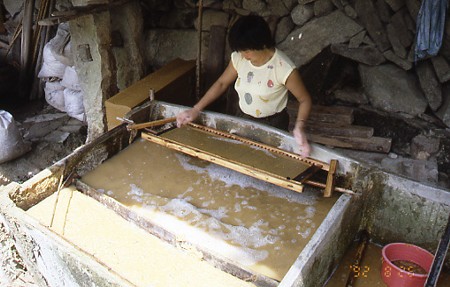 |
Scooping and straining the paper |
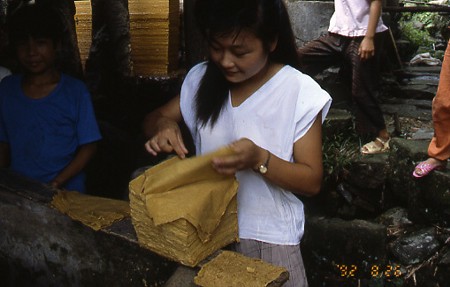 |
The paper is carefully stripped off sheet by sheet |
The Most Luxurious Paper in the World
At the time of my visit, the wholesale price of Nanping paper was
37 Yuan (China's currency unit)
per tiao 4000 sheets. (1 Yuan was approximately equal to 15 Yen.)
Subtracting expenses such as materials purchased and maintenance costs
of the watermills, the profit would be about 15 to 17 Yuan for each
tiao, and the annual profit from Nanping paper per person amounted
to 2250 to 2550 Yuan, since each person could produce an average of
about 150 tiao per year. In 1992, the average net income per person
in rural villages in China was a little less than 800 Yuan, so traditional
paper manufacturing was a fairly profitable activity as a secondary
job in an agricultural village.
I mentioned at the outset that this Nanping paper is the most luxurious paper in the world, and the reason lies in its peculiar usage. This hand-made paper, produced using time-proven techniques that have history of more than several centuries, through an intricate procedure that can be divided into many stages, and by elaborate handwork with a large amount of direct labor input, is used as, surprisingly enough, sanitary paper, that is, toilet paper. Imagine a piece of hand-made toilet paper. It has a soft and gentle touch, and excellent moisture absorption properties. This usage was possible only in China at that time, when labor costs were very cheap. According to an elderly member of the village, Nanping paper was also used as ordinary recording paper before the liberation of China about the middle of the 20th century. The specialized usage of the paper as sanitary paper can be regarded as a result of the stress on commodity production during the process of socialization, and also as a result of a niche strategy that was promoted as a reaction to the development of paper produced by machine.
Nanping paper was also used as paper money (zhiqian) here in Wenzhou. As mentioned above, an article in the Tiangong Kaiwu says that people in the Tang period worshipped the guishen demon and burned paper money, which was used as an offering to Hades and Heaven. Bamboo paper is still used as this kind of paper money here in the southern part of Zhejiang Province. In particular, inshore fishermen have a custom of throwing the paper into the sea before setting out on a fishing trip or when a storm is approaching, as an offering to the dragon. By offering paper money, which is a treasure in Hades, they pray to the dragon for clear sailing.
Whether it is used as sanitary paper or paper money, its usage is quite lavish enough. Traditional hand-made paper, which takes more than half a year to produce, and into which is put a good deal of time and effort, is destined to vanish in an instant into the sea or water closet. It is interesting that the difference between lavatory paper and sacred paper for the gods is literally "paper-thin." However, now the situation is beginning to change again.
At present, the beautiful mountain stream of Zeyazhen is being developed as a sightseeing area, and because of this, Nanping paper making is being given a new role as a traditional handicraft instead of a commodity industry. The consequences of this are still uncertain, but tradition, by its nature, changes as society changes, sometimes more flexibly than is usually imagined. Someday my piece of Nanping paper might fall out of my old field notebook again, having transformed itself into an example of traditional craftwork that is really expensive and luxurious.
Nanping paper (center) in a village toilet
References
@@ ฃ๏A1979w jโxใCระoละ
@@ เNgฏAฒกq๓@1980wปZpjxฝ}ะ
@@ hีศ๏A1995wถ[lxอ์ณ็oละ
@@ vไฏดAO}น๐เ 1943wVHJจx\๊goล
@@ vไฏ๏AๅMเด๓@1969wVHJจxฝ}ะ
SUGA Yutaka
(Associate Professor, The Institute of Oriental Culture) 16 June.2004